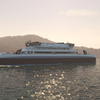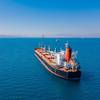April 27, 2004, marks one year since the Bouchard tank barge B. No. 120 ran aground and spilled approximately 55,000 gallons of Number 6 fuel oil in Buzzards Bay. Coast Guard Marine Safety Office (MSO) Providence has been working with several of its partners the past year to clean up the spill and to implement changes that can help prevent a similar disaster in the future.
To date, more than $40 million has been spent on cleanup efforts. 99.8 percent of the shoreline areas that were oiled as a result of the spill have been cleaned, inspected by a combined team representing federal, state, local, and responsible party representatives, and found to meet the cleanup criteria under Massachusetts state law. A state-licensed company, GeoInsight, Inc., was designated to direct cleanup operations with oversight by the Massachusetts Department of Environmental Protection (DEP) and United States Coast Guard in September 2003, when the Buzzards Bay Unified Command transitioned from the emergency response effort phase to a longer-term remediation effort under the oversight of DEP. The cleanup effort continues.
The Massachusetts Division of Marine Fisheries (DMF), in consultation with Department of Public Health (DPH), reopened 27,500 acres of beds on November 12, 2003. This re-opening allowed shellfish diggers to utilize productive flats off Dartmouth, New Bedford, Fairhaven, Mattapoisett, Marion, Wareham, Bourne, and Falmouth, in addition to the areas that were re-opened in May and October 2003. With this reopening, 97 percent of the Buzzards Bay beds closed in April, 2003 are now safe for human consumption. Sampling of the remaining three percent of closed shellfish beds still needs to be conducted.
In September 2003, MSO Providence hosted a two-day Ports and Waterways Safety Assessment (PAWSA) to examine the various risks to navigation safety within Buzzards Bay, including the Cape Cod Canal. The PAWSA produced a jointly developed action plan to help all waterways stakeholders address navigation safety risks in an organized, prioritized fashion.
One finding of the PAWSA was that the traffic mix between commercial vessels and recreational vessels in the vicinity of Rhode Island Sound, Narragansett Bay, and Buzzards Bay was a leading indicator of increased navigation risks. MSO Providence, the Northeast Marine Pilots, and the National Oceanic and Atmospheric Administration (NOAA) worked jointly to design and produce voluntary vessel routes to guide commercial traffic through the safest areas of Buzzards Bay, and to alert users as to where the concentrations of commercial traffic may be located. A voluntary vessel route through Buzzards Bay was approved by the Coast Guard and NOAA and adopted for inclusion on the next editions of the navigation chart 13230, “Buzzards Bay,” scheduled for publication in the spring of 2004.
MSO Providence is working with the U.S. Army Corps of Engineers at Cape Cod Canal on a proposal to expand the Corps’ electronic coverage of Buzzards Bay through use of the Automatic Identification System (AIS). Under the proposal, the Corps would monitor commercial traffic via AIS signals emanating from vessels transiting in Buzzards Bay and notify either the vessel itself, the Coast Guard, or both, if the vessel was detected veering from its intended route. An operational prototype of this proposal may be tested this year. The Coast Guard also plans to expand its shore-side AIS infrastructure to enable vessel tracking and improved navigation safety and collision avoidance in areas such as Buzzards Bay.
The U.S. Attorney announced a $10 million criminal settlement with Bouchard Transportation for the Buzzards Bay oil spill. The settlement formalized Bouchard's acceptance of a guilty plea for negligent operations resulting in the spill. The civil investigation continues.
The Coast Guard, DEP and NOAA have provided technical support to the Coalition for Buzzards Bay to develop a comprehensive, Geographic Information Based (GIS) response plan. The new plan will enable oil spill experts to quickly identify threatened environments and prioritize response strategies to minimize the effects of a spill.
Subscribe for
Maritime Reporter E-News
Maritime Reporter E-News is the maritime industry's largest circulation and most authoritative ENews Service, delivered to your Email five times per week










